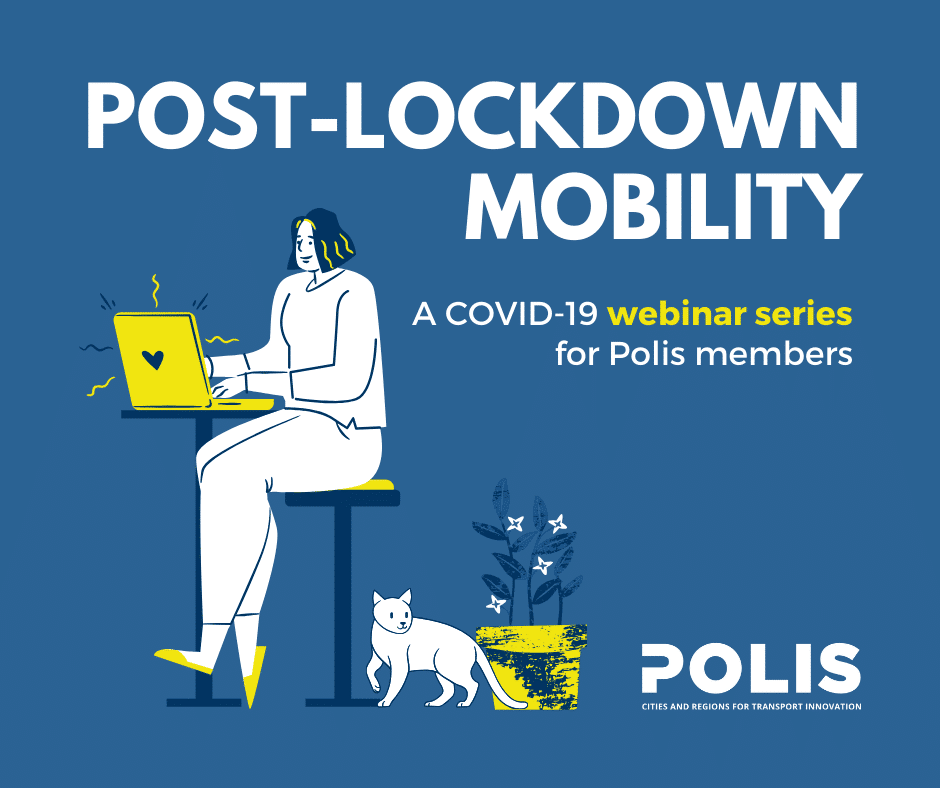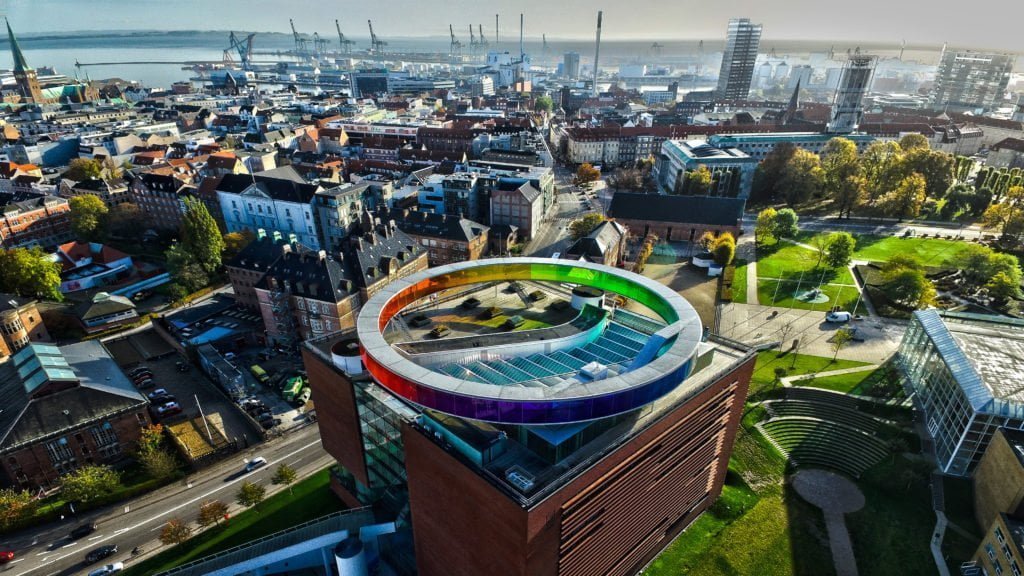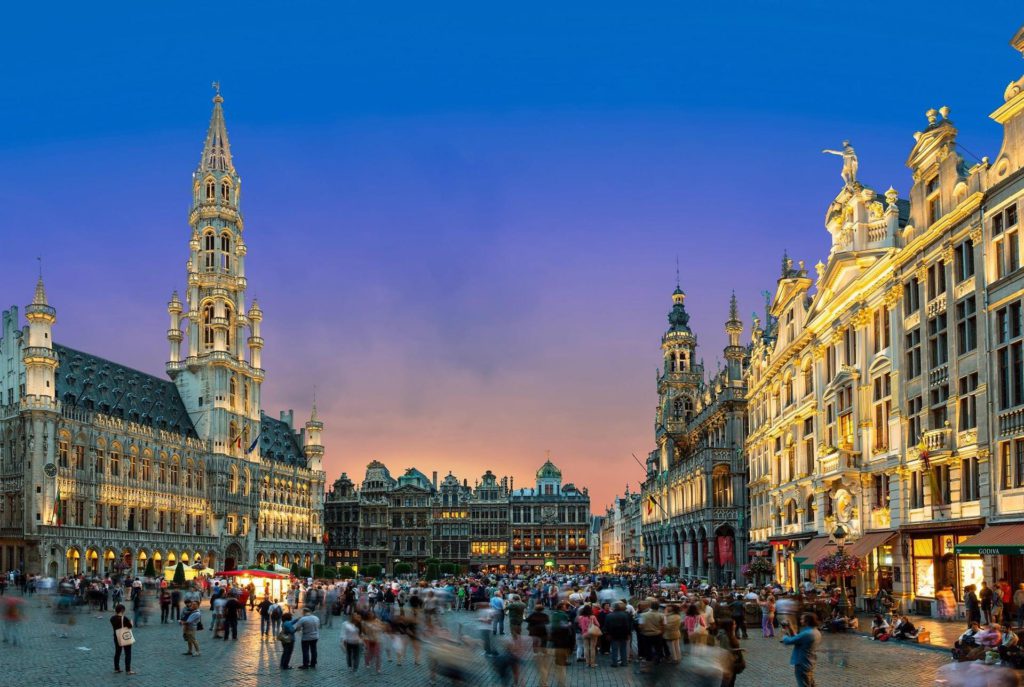Post-Lockdown Mobility webinar report: The post-lockdown strategies of Aarhus and Brussels
The first of POLIS’s Post-Lockdown Mobility webinars took place on Thursday 30 April. We were pleased to be joined by the cities of Aarhus and Brussels to present their plans for mobility post-lockdown. The webinar was hosted by POLIS Secretary General Karen Vancluysen, who began by praising POLIS members for their leadership in adapting urban mobility during this challenging time. Karen encouraged members to share their actions in urban mobility during and after lockdown and highlighted the Keeping Things Moving and Useful Resources pages on the POLIS website to keep members informed about how others are responding to COVID-19.
The integrated post-lockdown mobility strategy of Brussels
Elke Van den Brandt, Minister for Mobility, Public Works and Road Safety of the Brussels-Capital Region, presented Brussels’ strategy to adapt mobility post-lockdown in a way that it will make the city more people-focused than car-focused, a policy which had already been initiated prior to the health crisis.
Since lockdown measures came into place on 17 March, mobility has undergone drastic changes in Brussels. Car traffic has fallen by as much as 90%, with consequent problems arising with speeding vehicles. Public transport use was down by around 90%, with capacity limited to 50% of normal levels. With lockdown measures gradually easing from the 4th of May, public transport will return to 85% of operation, but only with 40% of capacity on each vehicle to allow for safe physical distancing. After an initial reduction, cycling rates increased greatly across Brussels during the lockdown, with up to a three-fold increase in cycling compared to pre-lockdown levels.
With both walking and cycling increasing considerably, concerns were raised about the need for more space for active travel, both to protect people from vehicles and to allow for safe physical distance from other people. This has highlighted the unfair distribution of public space in the city, with much of public space being dominated by private vehicles. With reduced public transport, and a desire to avoid a rise in car use, Brussels is now bringing forward plans to prioritise walking and cycling through the city post-lockdown.
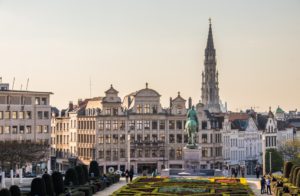 This is being achieved by fast-tracking pre-existing long-term plans to be implemented now in response to COVID-19. Firstly, a ‘neighbourhood’ approach will be taken to give greater priority to movement on foot and by bike and create a more welcoming urban environment. ‘Slow streets’ will be rolled out across the city to allow people to move more freely in streets, by reducing vehicle speeds to 20km/h and providing more space for walking and cycling. This will be complemented by a city-wide 30km/h standard speed limit from 2021.
This is being achieved by fast-tracking pre-existing long-term plans to be implemented now in response to COVID-19. Firstly, a ‘neighbourhood’ approach will be taken to give greater priority to movement on foot and by bike and create a more welcoming urban environment. ‘Slow streets’ will be rolled out across the city to allow people to move more freely in streets, by reducing vehicle speeds to 20km/h and providing more space for walking and cycling. This will be complemented by a city-wide 30km/h standard speed limit from 2021.
Secondly, a ‘network’ approach will be applied to allow everyone to move around the city easily and safely on foot or by bike. For cycling, an additional 40km of bike corridors will be implemented, using concrete blocks and paint. Major arteries such as Rue de la Loi will be prioritised, with many more in the pipeline. Whilst this reallocation of road space will not be supported by everyone, the city is keen to make clear that this is vital to keep people safe and can in fact help to reduce congestion by encouraging a shift from car use to cycling. For walking, traffic lights are being adapted to improve the flow of pedestrians across the city. A task-force has been established for medium- and long-term measures in favour of walking, with a view to keep some measures post-COVID.
For those unable to travel on foot or by bike, Brussels is making sure that as many people as is safe can travel on public transport. Public transport operator STIB will be operating at 85% post-lockdown and passenger limits will be imposed on each vehicle. As social distancing may not always be possible, the use of face masks will be mandatory. Cash payments will not be accepted and frequent cleaning will be carried out. However, the message for all citizens remains that if they can walk or cycle, they should leave public transport to those who need it the most. Strong challenges remain for public transport however, and with large reductions in revenue, some infrastructure projects are being put on hold.
Additional measures are being taken to support mobility post-lockdown in Brussels. Cycling is also being promoted and supported in other ways, such as by offering cycle training courses, promoting repair shops and ‘bike to school’ incentives. Some Shared Mobility Services (SMS) operators have stopped operations; for those that remain, hygiene standards have been put in place to keep people safe.
The minister finished by stating that whilst huge challenges will be faced, it is important to make the best of this situation. Problems will arise, particularly with public transport, but there are opportunities to be taken as well. In particular, enabling a wider range of people from different ages and abilities to travel by bike, and reclaiming public space for people, could be two huge opportunities for post-lockdown mobility in Brussels.
The integrated post-lockdown mobility strategy of Aarhus
Gustav Friis, Project Manager at Aarhus Kommune, shared Aarhus’s experiences so far in adapting urban mobility. Denmark was one of the first countries in Europe to go into lockdown and as such is ahead of other countries when it comes to gradually lifting the confinement measures. Gustav began by providing context on mobility in Aarhus and the city’s ambitions to continue its progress in achieving a modal shift towards sustainable mobility. Aarhus is facing rapid growth in the future and has to balance multiple transport needs, with the municipal area covering urban, suburban and rural settings.
Lockdown measures came into force Friday 13 March in Denmark, with restrictions increased up until 30 March. Denmark has taken a phased approach to lifting measures, with restrictions being eased gradually from mid-April. As with every other city, mobility has changed drastically in Aarhus since lockdown measures came into force. Car use was down by 58% in the first week of lockdown, but is gradually growing once again. Aarhus’s ‘environmental zone’ has been temporarily suspended to allow more deliveries into the city to support people and businesses, whilst plans for strengthening the environmental zone have been put on hold.
Public transport is facing major challenges, with passenger numbers having fallen by around 80% following lockdown measures. Strict rules have been implemented on public transport to avoid the spread of the virus, with official advice telling people to avoid using public transport unless absolutely necessary, avoid peak hours, and practice good hygiene at all times. As lockdown measures are eased, Aarhus Kommune are implementing restrictions on the number of passengers permitted, with a maximum of 40 people on each bus to allow for social distancing. Gustav highlighted that big questions remain for public transport, as increasing passenger numbers (and therefore revenue) will take a long time to recover.
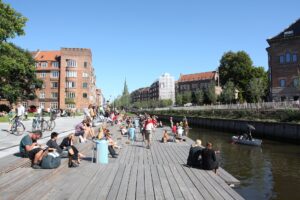
Gustav highlighted the potential role of New Mobility Services (NMS) to fill the gap in public transport and avoid an increase in car use. Whilst VOI has temporarily closed operations in Aarhus, Green Mobility (electric car-sharing) and Donkey Republic (bike sharing) are still operating and supporting the city, for example by offering services to health workers. However, the level of uptake of these offers is unclear, with Gustav positing that lessons remain to be learned about the role of NMS in urban mobility.
Gustav finished by posing several key questions going forward:
• How will we consider public transport in the coming months and years?
• Will public transport ever fully recover?
• What would be the replacement?
• Can NMS be part of the answer, and are their business models aligned to the goals of cities?
The presentation slides and a recording of the webinar are available exclusively for POLIS members. For information about the rest of our Post-Lockdown Mobility webinar series, please see our website.
